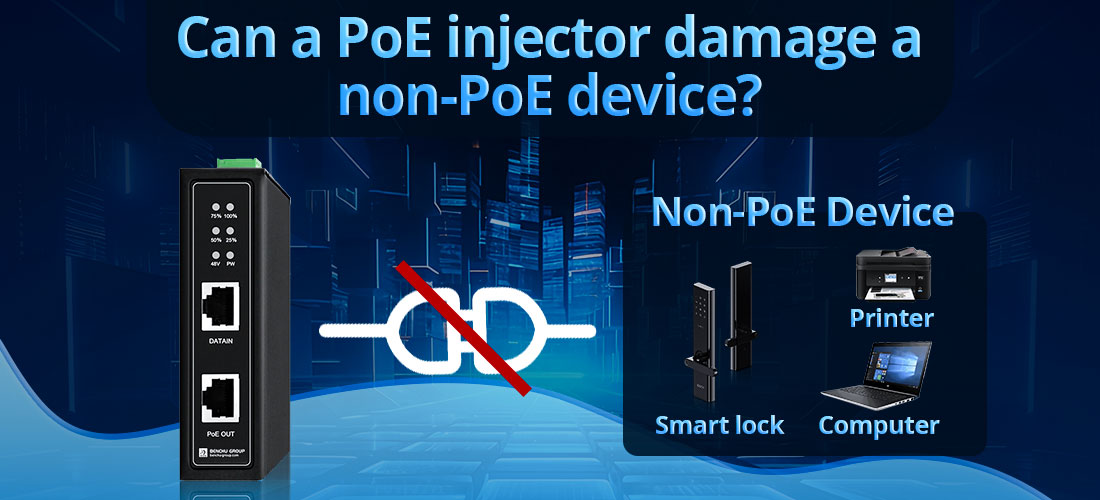
Oui, un injecteur PoE peut potentiellement endommager un appareil non-POE, mais seulement si un injecteur incompatible est utilisé. Le risque dépend de la question de savoir si l'injecteur est actif (conforme à l'IEEE) ou passif.
1. Comprendre comment fonctionnent les injecteurs de Poe
A Injecteur de Poe fournit de l'alimentation sur un câble Ethernet, permettant aux appareils de recevoir à la fois l'alimentation et les données via une seule connexion. L'injecteur envoie une tension CC via des broches Ethernet spécifiques tout en maintenant la transmission de données standard sur les broches restantes.
Injecteurs PoE actifs (IEEE 802.3af / AT / BT conforme)
--- Utilisez un protocole de poignée de main pour détecter si le périphérique connecté prend en charge PoE.
--- N'envoyez pas d'énergie si l'appareil est non-POE, assurant la sécurité.
--- Sécurité à utiliser avec les appareils POE et non-POE.
Injecteurs Poe passifs (non standard)
--- Envoyez toujours le pouvoir sans négociation.
--- peut livrer 24 V, 48 V ou supérieur, quelle que soit la compatibilité des appareils.
--- Risque de dommage aux dispositifs non-POE si la tension est incompatible.
2. Quand un injecteur POE peut-il endommager un appareil non-POE?
Un dispositif non-POE (par exemple, un ordinateur standard, une imprimante ou un commutateur sans support POE) peut être endommagé s'il est connecté à un injecteur POE passif ou à un injecteur non conforme qui force la tension dans le port Ethernet.
Scénarios où des dégâts peuvent se produire
| Scénario | Niveau de risque | Explication |
| Injecteur PoE actif (IEEE 802.3af / at / bt) à un appareil non-POE | Pas de risque | Les injecteurs de Poe avec une technologie de fabrication de la main détectent l'incompatibilité et n'envoient pas de puissance. |
| Injecteur PoE passif (toujours en puissance) à un appareil non-POE | Risque élevé | Offre une tension constante (par exemple, 24V ou 48 V), qui peut brûler le port Ethernet ou les circuits internes. |
| Injecteur POE non standard (marques bon marché et non réglementées) | Risque modéré à élevé | Peut fournir une tension incorrecte sans négociation, risquer la surcharge et la surchauffe de l'appareil. |
| Injecteur Poe avec un séparateur POE à un appareil non-POE | Sûr | Un séparateur POE extrait uniquement les données et supprime l'énergie, permettant une utilisation sûre avec des appareils non POE. |
3. Comment les injecteurs Poe actifs protègent les appareils non-POE
Les injecteurs PoE actifs conformes à l'IEEE (802.3af, 802.3at, 802.3bt) comprennent un processus de négociation de puissance:
--- Phase de détection: l'injecteur envoie une petite impulsion de tension pour vérifier si l'appareil répond par une signature POE.
--- Phase de classification: si l'appareil est compatible POE, l'injecteur attribue le niveau de puissance correct.
--- Livraison d'alimentation: ce n'est qu'après la vérification que l'injecteur envoie de l'alimentation via le câble.
--- Mécanisme de protection: si aucune signature POE n'est détectée, la puissance n'est pas envoyée, assurant la sécurité des dispositifs non-POE.
Les injecteurs PoE actifs n'endommageront jamais un appareil non POE car ils ne fournissent pas de puissance à moins que l'appareil ne le demande.
4. Comment éviter les dommages lors de l'utilisation d'un injecteur PoE
Utilisez un injecteur POE conforme à l'IEEE actif
--- Choisissez toujours des injecteurs qui suivent les normes IEEE 802.3af / AT / BT.
--- Évitez les injecteurs bon marché ou génériques qui peuvent manquer de négociation de puissance appropriée.
Vérifiez la compatibilité de votre appareil
--- Vérifiez si votre appareil est Poe ou non-POE avant de le connecter à un injecteur.
--- Si le périphérique est non-POE, n'utilisez pas un injecteur POE passif.
Utilisez un séparateur POE pour les appareils non POE
--- Un séparateur POE sépare la puissance et les données, permettant à un dispositif non-POE de recevoir des données en toute sécurité uniquement.
--- Le séparateur extrait la puissance et le convertit en une sortie CC séparée pour les appareils qui nécessitent de la puissance mais ne prennent pas en charge PoE.
Évitez les injecteurs Poe passifs sauf si nécessaire
--- Utilisez uniquement des injecteurs PoE passifs avec des appareils spécialement conçus pour gérer le POE passif.
--- Si ce n'est pas sûr, ne connectez pas un dispositif non-POE à un injecteur POE passif.
5. Conclusion: un injecteur PoE peut-il endommager un appareil non-POE?
Les injecteurs PoE actifs (IEEE 802.3af / AT / BT sont en sécurité) et n'enverront pas de puissance à un appareil non-POE.
Les injecteurs PoE passifs peuvent endommager les dispositifs non POE car ils fournissent de l'énergie sans vérifier la compatibilité.
Vérifiez toujours la compatibilité et utilisez des séparateurs POE lors de la connexion des appareils non POE aux réseaux alimentés par POE.
Recommandation: Si vous ne savez pas si un appareil prend en charge POE, utilisez toujours un injecteur PoE actif certifié pour éliminer le risque de dommages.